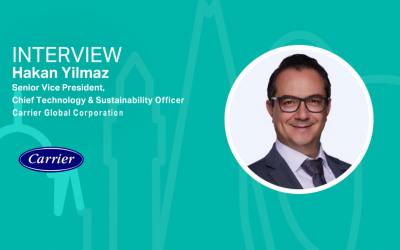Jens Mueller on how real estate investors build sustainability into their portfolios
Jens Mueller, CEO at BuildingMinds, talks to Climate Action about how effective ESG performance is reliant upon investors having access to rigorous nonfinancial data and how the physical must be fused with the digital to ensure the highest level of organisational intelligence.

Sustainability in real estate: understanding and managing the factors that contribute to both creating and reducing carbon emissions in real estate portfolios.
Jens Mueller, CEO at BuildingMinds, talks to Climate Action about how effective ESG performance is reliant upon investors having access to rigorous nonfinancial data and how the physical must be fused with the digital to ensure the highest level of organisational intelligence.
In your opinion is sustainability a fundamental concern for real estate investors and how do they build sustainability into their portfolios?
Asset owners are managing their portfolios with horizons that often exceed decades or even longer. While a long horizon make it possible to withstand short-term volatility, portfolios are likely to be exposed to higher levels of long-term risks such as the climate risk.
Today’s number one priority is understanding and managing the factors that contribute to creating and reducing emissions of real estate portfolios. It is an open secret that the real estate industry bears a huge responsibility: buildings account for around 38% of energy-related carbon dioxide emissions. And "the world is already built." At least 80% of today's buildings will still be in use in 2050, and about 75% of the world's building stock is currently energy inefficient.
It’s an open secret that nonfinancial KPIs are moving from the fringes of business management to the center stage and factors such as business sustainability, equality, and a clean environmental record become essential facets of a long-term financial performance. In other words, nonfinancial KPIs finally become financial ones.
Take an office property in Berlin, built in 1980 with a floor area of 2,000 square meters. This building could incur additional costs of over €180,000 by 2050 unless adequate decarbonization measures are taken to reduce or avoid emissions penalties. This “climate change penalty” corresponds to just under 3.1% of the market value (€6 million) of the property used in this example. The penalty imposed on the building is based on the scope of the fines contained in the recently enacted New York Climate Mobilization Act. Even if one only applies the penalty for fossil fuel emissions defined in the German Fuel Emissions Trading Act, the building still faces additional costs with a present value of around 1.3% of its market value. Anyone with a rough idea of the returns that can be generated by our sample property would break into a cold sweat when hearing this.
What are the common difficulties when trying to effectively mine ESG data?
Companies are becoming increasingly aware that ESG implementation and / or future-proofing their portfolios against climate change, pandemic risks and other anticipated crises requires informed decision-making based on consistent data. However 71% of real estate companies see the lack of transparency and quality of their data as a major challenge. Creating transparency for every bit of information in and around every single building, its stakeholders and multiple life cycle stages is the essential foundation. In a nutshell: We have to fuse the physical with the digital to ensure the highest level of organisational intelligence.
Leading businesses in real estate have clearly recognized that this endeavor requires a new analytics, benchmarking and evaluation approach
- For formal evaluation of ESG performance to be more effective, investors need more standardized and rigorous nonfinancial data
- Disclosures have to be clear, transparent and founded on high-quality data
- To create integrated decision-making processes based on data-driven insights, organizations have to transform and develop business agility
- To unlock these potentials, all kinds of data need to be gathered, harmonized and democratized, enriched by industry-specific standards and processed using robust and reliable processes and systems
ESG implementation and digitalization are not only the most relevant drivers of innovation for the real estate industry, they are inseparably linked.
How has benchmarking assisted in managing portfolio decarbonisation?
Internal (against other building) and external (against standards / scorings) benchmarking is crucial to understand the environmental performance of a portfolio and to derive the right actions.
For real estate portfolios and in the area of the “E” in ESG, it is vital to benchmark portfolio and building data against the Carbon Risk Real Estate Monitor (CRREM), the first benchmarking system that has calculated country and building type-specific decarbonization pathways at the building level.
The exact stranding moment and the impact of missing or reaching energy-intensity or carbon-intensity targets is determined by comparing the portfolio’s or buildings’ carbon emissions to CRREM targets for +1.5° or +2.0°C climate warming until 2050. With advanced carbon pricing simulations, the saving potential can be calculated and visualized based on different emission tax or penalty fee scenarios.
On this basis, a roadmap to net zero can be effectively defined based on (if needed further industry benchmarks) and carbon pricing scenarios. Determine stranding risk exposure and retrofit requirements up to building type and location-specific parameters.
How do data driven insights mitigate risks and do they allow for long term value creation? Can AI and machine learning accelerate sustainability efforts in general?
Data-driven analytics can uncover underlying trends and new potential not identified by traditional methods. For example, comparing the energy use of one building to that of another similar building in the same zip code area can reveal a new metric for improving ESG goals. Elevator usage analysis, for example, can reveal where the focus of human movement is and where, or how, resources could be reallocated. Such insights can give any building or complex an edge in highly competitive real estate markets. McKinsey estimates that nearly 60% of predictive power can come from non-traditional variables. Smart AI implementation is key to processing vast amounts of data and gaining critical insights from previously unrelated data points.
AI in decarbonization management enables a transparent recommendation for optimal portfolio decarbonization roadmaps based on all data-points available maximize carbon reduction while minimizing and spreading investment cost and prevent buildings from stranding. With additional information on vacancies, lease contract periods, revenue and profitability, equipment lifecycle and structural quality, to ensure that a roadmap doesn’t remain theoretical but can become a blueprint for real world implementation.






